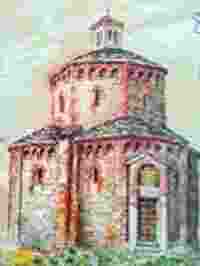Saragozza

In the village of Calanda March 29 th 1640, for intercession of the Virgin of the Pilar, to a young farmer was returned of hit the right leg.
Join us
THE MIRACLE IN ZARAGOZA CALANDA
A shocking Miracle
On March 29th 1640, through the intercession of Our Lady of the Pillar in Zaragoza, in the village of Calanda a young farmer regained the right leg, amputated more than two years earlier and buried in the hospital cemetery. After long and careful consideration of all the archives and the places concerned, the journalist Vittorio Messori, in a recent book, presents the story of the shocking miracle.
Miguel Juan Pellicer was twenty at the beginning of 1637 when he moved from the village of Calanda, where he had been born in a poor and numerous family, to Castellon de la Plana about 60 km from Valencia, to work as a laborer for his maternal uncle Joime Blasco. One day, in late July of 1637, while leading a two-wheeled farm wagon loaded with grain, riding one of the mules , maybe asleep, he fell to the ground and the two-wheeled wagon ran over his right leg, below the knee, fracturing the tibia.
He received first aid in Castellón and then was accompanied by his uncle to the hospital in Valencia, where he stayed only five days: he decided to seek treatment in Zaragoza, which is more than 300 km away and the journey took 50 days. First, however,he stopped at the famous shrine of Our Lady of Pilar where he went to confession and received Communion and recommended himself to the Blessed Virgin.
On arrival, the head of the hospital, Professor Juan de Estanga, along with his colleagues, found that the gangrene was too severe and that the only way to save his life was to amputate the leg. The operation was carried out in mid-October. The leg, according to the customs of the time, was taken to a special area in the cemetery of the hospital. Pellicer remained hospitalized for several months, he was released in the spring of 1638 with a wooden leg and crutches. He lived for the next two years as a beggar at the shrine of Our Lady of Pilar in Zaragoza. Every evening,he anointed the stump of the leg with a little 'oil from the eighty lamps that burned continuously in the Lady Chapel, convinced that in this way he could obtain the help of the Virgin. In March of 1640 the curate, from his home town, Don Giuseppe Herrero, persuaded him to return to his home, assuring him the affection of his family, so he decided to return to Calanda to his parents.
On the evening of March 29th, after a meager dinner, he went to sleep on a makeshift bed for the night, since his bed had been given to a soldier of the garrison of Calanda. The mother at about 11 pm, carrying an oil lamp, entered the room where her son was asleep and "she smelled a scent never smelled before" and saw that Miguel did not have one foot, but two, "cruzados," crossed, as she testified later at the process. The son woke up, he said that he was dreaming of being in the sanctuary of Pilar and was anointing his leg with blessed oil :he was convinced that the healing had been the intercession of Our Lady of Pilar.
The news spread immediately and people rushed to Calanda from neighboring towns to see the regrown leg . The town judge, assisted by two surgeons, Pellicer examined Pellicier and prepared a report for his superiors. Don Marco Seguer, pastor of Mazaleón, on Palm Sunday, went to Calanda accompanied by Miguel Andréu,a royal notary, the notary drew up a deed in which he verbalized the sworn testimony of ten people.
At the request of the municipal authorities, a formal investigation was launched to ascertain the veracity of the facts. The process presided over by Msgr. Pedro Ramirez, began on June 5th and continued for about a year. Twenty four witnesses,selected as the most reliable, were heard.
The Archbishop of Zaragoza on April 27th 1641, issued the results, with which he officially recognized the authenticity of the miracle. From the reports emerged that the new leg appeared to be the same leg that had been amputated two and half years earlier, it was recognized by some pre-existing scars and scratches, and when the hospital in Zaragoza dug the grave where it had been buried the place was empty.
The judgment was categorical: "We declare that to Miguel Juan Pellicer, a native of Calanda, his right leg, which previously had been amputated,was miraculously returned and that it was not by work of nature, but by an admirable and miraculous event, and this must be considered a miracle,in accordance with all the conditions required by the law ... "The text of the judgment is in Latin.
 In the village of Calanda March 29 th 1640, for intercession of the Virgin of the Pilar, to a young farmer was returned of hit the right leg.
In the village of Calanda March 29 th 1640, for intercession of the Virgin of the Pilar, to a young farmer was returned of hit the right leg.